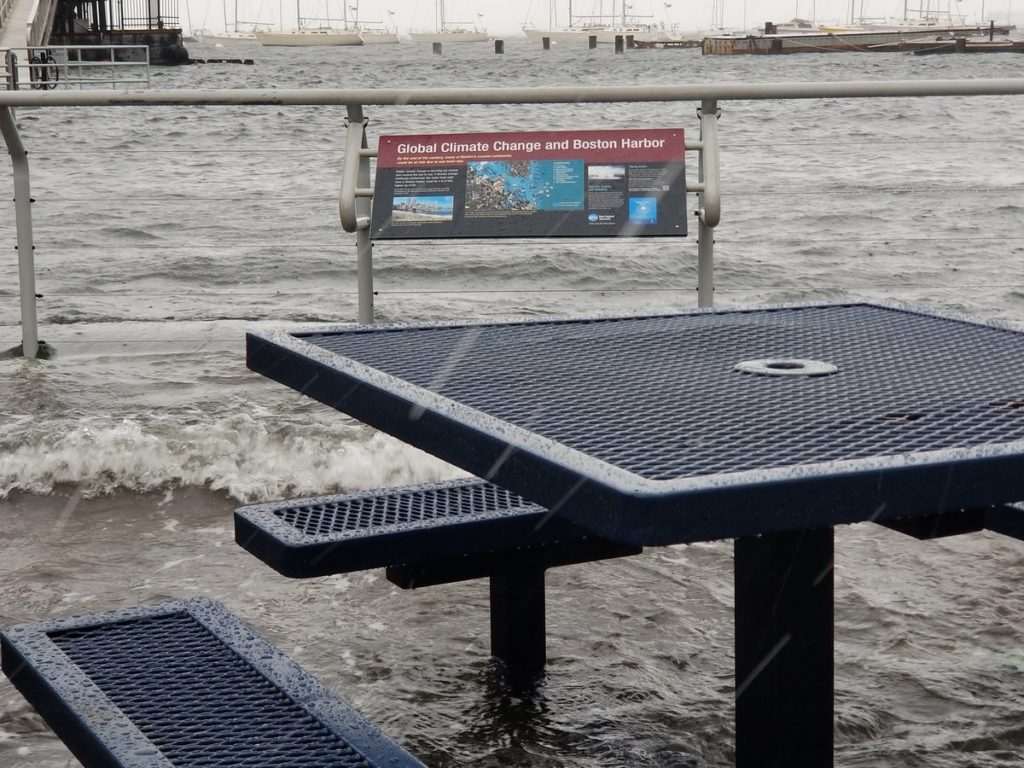by MARIA VIRGINIA OLANO POLICY AND RESEARCH FELLOW MARCH, 6TH, 2018
Last Friday, Boston experienced a bomb-cyclone, resulting in the third-highest storm tide on record, at almost 15 feet. The Nor’easter struck a mere seven weeks since I wrote a piece about a similar storm that also caused major flooding along the coast.
More than 2 million households and businesses in 13 states across the Northeast lost power on Friday and Saturday morning, as the storm came in with hurricane-strength winds and heavy rainfall. Power lines and trees fell on the streets and homes across the east coast, killing at least six people and shutting down airports, roads and train services. Flood warnings extended portions of the East Coast from Maine to North Carolina.
The walls of water engulfing coastal communities and major cities across the Northeast last weekend, including again parts of Boston’s downtown neighborhoods, once again raise concerns over how we will endure rising sea levels and increased storm surges due to climate change. It seems these recent storms are but a preview of the kind of extreme flooding we can expect in the not-so-distant future. Climate change and its resulting extreme weather events have severe and dire consequences for coastal communities in terms of public safety, access, and the overall operation of our port economies.
Matt Beaton, Massachusetts’ Secretary of Energy and Environmental Affairs said in a Twitter message, “I think [the storm] highlights our most obvious vulnerabilities to climate change.” He added, “The frequency and intensity of these events are alarming and I think we are experiencing things we are likely to see more often in the future.”
In the aftermath of flooding events such as last week’s storm, we are faced with the tragedies, cost and challenges resulting from flooding. And therefore, we are faced with the need to reckon with another looming threat: sea level rise.

Photo Credit: Matt Beaton
Climate Ready Boston estimates that by the end of the century, Massachusetts could experience up to 10 feet of sea level rise and the area of land exposed to stormwater flooding is also projected to grow throughout the century. As soon as the 2050s, seven percent of the total land area in the city could be exposed to frequent stormwater flooding from 10-year, 24-hour rain events.
But this is not new information. We have been seeing maps of Boston’s projected flooding for years and many have warned about the vulnerability of the city to climate change, yet little action has been taken to tackle or mitigate those threats. We can no longer speak of the ‘future’ effects of global warming, because they are happening now, and they are happening here. Last week’s storm as well as the one that hit on the first week of the new year are real and present manifestations of increased extreme weather events.
While Massachusetts has set ambitious climate goals for itself, they remain mere hopes without real legislative action to make them happen. With such obvious and manifest climate effects on the community, it would be only obvious that the state should be leading the way on climate change legislation nationally.
We must take these extreme weather events such as the ones we have experienced this winter, as not only warnings but catalysts for climate action and comprehensive legislation. “They’re just going to keep getting hit anytime there’s a big storm. That means we’re going to need some different answers,” said Governor Baker of areas along the coast. Agreeing that, “We have a lot of work to do on this one.”
The ‘Act Establishing a Comprehensive Adaptation Management Plan in Response to Climate Change’ (CAMP) currently before the legislature can address the challenges and mitigate the vulnerabilities we have seen due to storm flooding. Our communities are not prepared to deal with the consequences of climate change, and this bill could help change that. The CAMP bill would require the the Commonwealth to create a report with data on expected impacts and a vulnerability assessment of communities and critical sectors. It would also establish best management practices and adaptation strategies for increasing the resiliency of the state and create a grant program to provide financial assistance to regional planning agencies. CAMP also creates a buyback program for homeowners whose properties are affected by coastal and other flooding, and empowers regional agencies to provide greater technical assistance to communities around the state.
In late 2017 CAMP legislation passed the state Senate with near unanimous support. It is now before the House, which has a chance to take action on the legislation. CAMP provisions are also present within the Senate’s 2018 Clean Energy Omnibus Bill. Passing either of these two provisions into law would achieve state goals for climate adaptation and mitigation. They are measures that should be codified in order to be able to directly improve the ability of local communities to deal with events such as last week’s storm. It also equips businesses and private citizens with the information they need to better understand the local impacts of climate change and better plan for them. In this sense, it is the logical and necessary next step for the state legislature to take in the planning for future climate resiliency.
 MARIA VIRGINIA OLANO
MARIA VIRGINIA OLANO
Maria Virginia is a young professional with experience in non-profit and coalition organizing in the areas of disarmament and human rights. She is currently pursuing a Masters degree in Security and Resilience Policy at Northeastern University, where she also completed her undergraduate degree in Political Science. During her time at Northeastern she studied abroad in Japan, India and Saudi Arabia and worked as a journalism intern in Bosnia Herzegovina and Turkey. She is passionate about travel and photography and in her free time loves to watch movies, eat lots of food and read.









